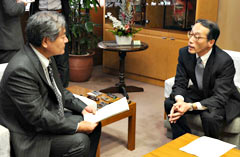Japanese Ministry of Defense does not give reasoning behind the stationing the U.S. Marine Corps in Okinawa

At the Okinawa Prefectural Office on December 20, Ro Manabe, who has assumed the post of Okinawa Defense Director, hands over the written responses to Okinawan Vice Governor Kanetoshi Yoseda (left). One set of responses concerned the U.S. Marine Corps in Okinawa and the other was regarding deployment of the Osprey to Futenma Air Station.
December 21, 2011 Ryukyu Shimpo
On December 20, the Ministry of Defense responded to questions posed by the Okinawa Prefectural Government (OPG) with regard to “The role and importance of the United States Forces in Japan including the Marines Corps.” The Defense Ministry booklet with this title gives reasons for stationing the U.S. Marines Corps in Okinawa, and also provides answers to questions about the MV-22 Osprey vertical take-off and landing transport aircraft that is scheduled to be deployed at Futenma from summer 2012.
However, the Ministry provided no clear answers regarding the validity of the claim made by the governments of both countries that the stationing of the Marines in Okinawa serves as a deterrent in the Asia Pacific region. With regard to the Osprey, the Ministry reported that the noise from this aircraft during hovering, take-off and landing is greater than that generated by aircraft currently deployed, and that in the past, high-temperature exhaust gas emission has caused fires to break out on the Osprey aircraft.
Okinawa Defense Director Ro Manabe visited Okinawan Vice Governor Kanetoshi Yoseda on December 20 to hand over the written response to questions posed. The Ministry is responding to questions from the OPG about the Osprey aircraft for the second time.
With regard to “The role and importance of the United States Forces in Japan including the Marines Corps,” the Ministry pointed out that if the Marines are relocated to Kyushu or the main islands of Japan, the greater distance involved means that they would not have sufficient time to respond in the event of an emergency situation in the Taiwan Straits or South-East Asia. However, the Ministry did not give any details of the role that the Marines would assume in situations envisioned, nor did it provide any basis for their stationing in Okinawa as a deterrent in the region. With regard to the situation surrounding North Korea, which is expected to become increasingly unstable, the Ministry did state that in the event of an emergency there, the Marines would be at an advantage in terms of deployment if they were stationed in Kyushu or the main islands of Japan, which are closer to Korean Peninsula.
The Ministry reported that Omura Airport (Japan Maritime Self-Defense Force Omura Air Base in Nagasaki Prefecture), Saga Airport and Guam, Tinian Island and Tokunoshima were considered by the Hatoyama administration for the relocation of Futenma Air Station. However, the Ministry did not give a clear reason for not relocating the base and its personnel to any of these locations. It reported that in addition to the option of relocating the base to Henoko in the Nago district, the central government also considered relocation to a land-based section of Camp Schwab or integrating the functions of Futenma with those of Kadena Air Base.
At the same time, the Ministry offered only a general conclusion with regard to the central government returning to the plan of relocating Futenma Air Station to Henoko, saying that “Okinawa offers logistical advantages over other prefectures.”
Among the various U.S. Army, Navy, Air Force and Marine units deployed in Okinawa, the Ministry emphasized the importance of the Marines, saying, “Only the Marines have ground forces.” Although the Ministry pointed out that the Marines play a vital role in exercising deterrence in the regions, it did not clearly state how important the Marines are in terms of achieving such “deterrence.”
(English translation by T&CT, Mark Ealey)

Go To Video
Previous Article:Korean junior golfers invited come to Okinawa
Next Article:Naha Airport ranks 5th in the country in terms of annual passenger numbers
[Similar Articles]
- Osprey aircraft fly from Futenma Air Station to Guam for training
- Osprey crashes in Hawaii, one dead; same model as Ospreys deployed at Futenma
- US Marine MV-22 Osprey crashes off east coast of Nago, 2 of 5 crewmembers hurt
- U.S. military to deploy more Osprey to Okinawa
- OPG to ask Ministry of Defense for a reassessment of the environmental impact of Osprey
 Webcam(Kokusai Street)
Webcam(Kokusai Street)


